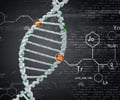A new study has provided direct evidence that biological clocks can influence the activity of a large number of different genes in an ingenious fashion.
A new study has provided direct evidence that biological clocks can influence the activity of a large number of different genes in an ingenious fashion, just by causing chromosomes to coil more tightly during the day and to relax at night.
Previous studies have discovered that biological clocks help organize a dizzying range of biochemical processes in the body. However, despite a number of hypotheses, exactly how the microscopic pacemakers in every cell in the body exert such an extensive influence has remained a mystery so far.“The idea that the whole genome is oscillating is really cool. The fact that oscillations can act as a regulatory mechanism is telling us something important about how DNA works: It is something DNA jockeys really need to think about,” said Vanderbilt University Professor of Biological Sciences Carl Johnson, who headed the research.
Johnson’s team performed the study with cyanobacteria (blue-green algae), the simplest organism known to possess a biological clock. The chromosomes in cyanobacteria are organized in circular molecules of DNA.
In their relaxed state, they form a single loop. But, within the cell, they are usually “supercoiled” into a series of small helical loops. There are even two families of special enzymes, called gyrases and topoisomerases, whose function is coiling and uncoiling DNA.
The researchers focused on small, non-essential pieces of DNA in the cyanobacteria called plasmids that occur naturally in the cyanobacteria. Because a plasmid should behave in the same fashion as the larger and more unwieldy chromosome, the scientists consider it to be a good proxy of the behavior of the chromosome itself.
When the plasmid is relaxed, it is open and uncoiled and, when it is supercoiled, it is twisted into a smaller, more condensed state. So, the researchers used a standard method, called gel electrophoresis, to measure the extent of a plasmid’s supercoiling during different points in the day/night cycle.
Advertisement
“This is one of the first pieces of evidence that the biological clock exerts its effect on DNA structure through the coiling of the chromosome and that this, in turn, allows it to regulate all the genes in the organism,” said co-author Mark A Woelfle.
Advertisement
The researchers see no reason why the bioclocks in higher organisms, including humans, do not operate in a similar fashion.
“This could be a universal theme that we are just starting to decipher,” said Woelfle.
Previous studies have shown that in higher organisms between 5 to 10 percent of genes in the genome are controlled by the bioclock, compared to 100 percent of genes in the cyanobacteria. In the case of the higher organisms, the bioclock’s control is likely to be local rather than the global situation in cyanobacteria.
The study is published online in the Proceedings of the National Academy of Sciences.
Source-ANI
SRM/S









